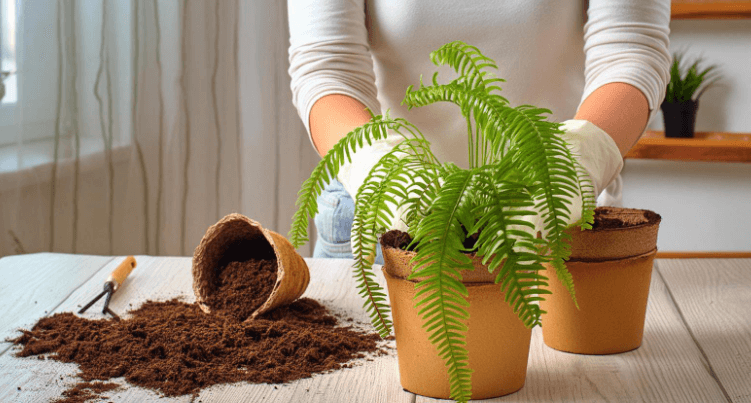How to Propagate Boston Ferns: A Step-by-Step Guide

Introduction:
Propagate Boston ferns plants, otherwise called Nephrolepis exaltata, are a famous choice for indoor and open air finishing because of their rich, green foliage and capacity to flourish in different conditions. Engendering Boston plants is a moderately straightforward cycle that should be possible through division, spores, or leaf cuttings. Here is a bit by bit guide on the most proficient method to engender Boston plants:
Can I propagate Boston ferns through leaf cuttings?
Indeed, Boston greeneries can be proliferated through leaf cuttings. This technique includes removing a part of the frond and establishing it in a preparing blend. Be that as it may, it’s less considered normal and may not be all around as compelling as division or spore spread.
Propagation through Division
Division is the most well-known strategy for proliferating Boston greeneries. This includes isolating the plant into more modest segments, each containing a rhizome (thick underground stem) and roots. This is the way to make it happen:
- Prepare the Plant: Prior to isolating the Boston greenery, ensure it’s solid and has a powerful underground root growth. Pick a plant with various fronds (leaves) and a thick, sinewy rhizome.
- Dig and Remove: Cautiously uncover the whole plant, taking consideration not to harm the roots. Carefully kill the soil from the roots, and subsequently wash the roots with water to wipe out any extra soil.
- Separate the Rhizome:Recognize the rhizome, the underground, thick stem that connects the fronds. Use a sharp, clean edge or pruning instrument to cut through the rhizome, detaching the plant into additional unassuming sections meticulously. Each part ought to have no less than one frond and a piece of the rhizome.
- Replant: Make sure that the rhizome is buried and that the fronds are above the soil before planting each section in a potting mix that drains well. Water completely and keep the dirt reliably clammy until the new plants are laid out.
Propagation through Spores
Boston greeneries can likewise be spread through spores, which are the regenerative designs of the plant. This strategy is really difficult and requires a controlled climate, yet it very well may be a tomfoolery and remunerating experience for experienced nursery workers.
- Collect Spores: Gather spores from the underside of the fronds, where they are regularly tracked down in groups. Utilize a little brush or a q-tip to clear the spores into a compartment tenderly.
- Create a Spore Bed: To make a spore bed, combine the collected spores and a small amount of water. The spores can be placed in a shallow dish or tray with a thin layer of water to accomplish this. Cover the dish with saran wrap or a reasonable plastic sack to keep up with mugginess.
- Incubate: The spore bed should be kept in a warm, humid space akin to a terrarium or nursery.For the spores to grow, the temperature needs to be between 65°F and 75°F (18°C and 24°C).
- Keep the spore bed clammy and trust that the spores will develop, which can require half a month.
- Transplant: When the spores have sprouted and formed into little fronds, relocate them into individual pots loaded up with a well-depleting preparing blend. Water completely and keep the dirt reliably clammy until the new plants are laid out.
Propagation through Leaf Cuttings
Boston plants can likewise be spread through leaf cuttings, which includes removing a segment of the frond and establishing it in a preparing blend. This technique is more uncommon however can be compelling for spreading explicit assortments of Boston greeneries.
- Choose a Healthy Frond: Select a sound, mature frond with a thick, beefy base. Try not to take cuttings from frail or harmed fronds, as they may not root well.
- Cut the Frond: Cut the frond around 1-2 inches (2.5-5 cm) from the base, trying to incorporate a little piece of the rhizome. Cut at a 45-degree point to support establishing.
- Prepare the Cutting: Eliminate any lower leaves from the cutting, leaving just the best a few leaves. This keeps the removal from drying and diminishes the gamble of parasitic contaminations.
- Root the Cutting: Place the cutting in a pot loaded up with a well-depleting preparing blend, covering it up to the foundation of the leaves. Water completely and keep the dirt reliably wet until the cutting has established, which can require half a month.
Conclusion
Propagate Boston ferns greeneries can be a tomfoolery and remunerating experience for nursery workers, all things considered. Whether you want to propagate by division, spores, or leaf cuttings, these easy steps can help you grow new Boston ferns successfully. With legitimate consideration and support, these wonderful plants can flourish in different conditions, settling on them a famous decision for both indoor and outside finishing.
FAQs:
Can you grow Boston fern from cuttings?
While engendering Boston greenery plants, just eliminate the Boston greenery sprinter from the foundation of the plant, either with a delicate pull or cut with a sharp blade. It isn’t required that the offset have roots as it will effectively foster roots where it comes into contact with soil
What is the easiest way to propagate ferns?
The speediest method for developing more greeneries is through division, ideally in spring. Begin by watering your plant the day preceding you start. Then, at that point, uncover it or delicately eliminate it from its holder, and cut or maneuver the plant into 2 or 3 bunches. Leave somewhere around one developing tip — the spot from which the fronds develop — in each bunch.
How do Boston ferns reproduce?
Boston ferns can be propagated in three primary ways: by division, spore propagation, and root division.




